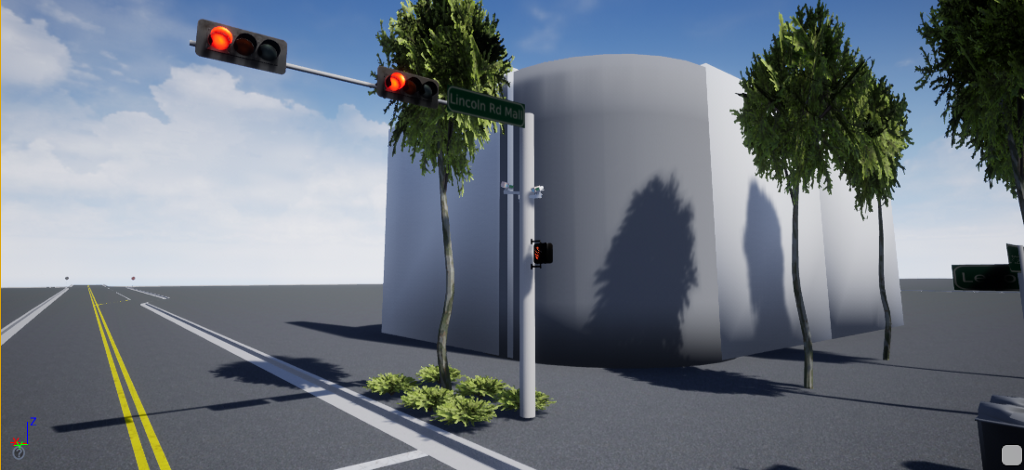By Tony Lockwood, Autonomous Vehicle Manager, Virtual Driver Systems, Ford Motor Company

Half a mile. It may not sound like a long distance when you’re in a car, but imagine being able to know exactly what is happening around the corner ahead at a busy, complicated intersection before you approach it. You’d know if anyone was approaching a traffic light at an unsafe speed, or whether to keep your eyes peeled for a group of pedestrians out of your line of sight.
That’s pretty valuable information that could help improve safety for everyone involved. A self-driving vehicle already analyzes its immediate surroundings and what is coming directly ahead, but what if it could see even further out before arriving at an intersection? At Ford, that’s exactly what we’re researching.
Playing It Safe. There Is No Other Way to Launch Self-Driving Cars
Researching smart infrastructure and self-driving vehicles: Situated above an intersection, a new infrastructure node designed by Ford can get a comprehensive view of what’s happening in all directions and offer a bird’s-eye view of knowledge to support the self-driving vehicle, which at the same time is also analyzing its immediate surroundings at street level. Equipped with sensors like radar, LiDAR and cameras, our infrastructure node quickly relays information to our self-driving research vehicles and lets them know exactly what kind of situation they are about to encounter as they approach an intersection.
Why this is important for self-driving vehicle development
· Some intersections have complex layouts that can minimize or obstruct the view of a self-driving vehicle, so this technology can help it get a more comprehensive view of the surrounding world to see traffic lights, pedestrians around corners and even cyclists.
· For example, this is helpful if a bus or truck is blocking a self-driving vehicle sensor’s direct line of sight. With information from the infrastructure node, the vehicle may know even quicker if another car is approaching from around the corner at an unsafe speed.
· This information can be used to reduce the likelihood our self-driving vehicles need to harshly hit the brakes due to an unseen pedestrian — and to ensure a smoother ride for passengers.
· At the end of the day, these learnings can help us provide a safe self-driving experience.

Research is kicking off in Michigan: There are many places we think our infrastructure node could be helpful, but we’re starting out by testing it at two key intersections in Saline, Michigan. These nodes will be installed on Michigan Avenue and Ann Arbor Street and on Michigan Avenue and Monroe Street — both in popular areas full of shops and restaurants with a heavy flow of vehicles, pedestrians and bicycle traffic. Over the next few months, we will work alongside the city of Saline, the Michigan Department of Transportation and our team at Quantum Signal AI, a wholly owned subsidiary of Ford, to install the smart infrastructure nodes.
An example of C-V2X: If this infrastructure node technology sounds familiar, it’s because Ford has already been thinking about how vehicles can communicate or “talk” to other connected objects in the future. Known as cellular vehicle-to-everything, or C-V2X, this is a wireless communication technology that uses cellular data to talk to similarly equipped vehicles, people and infrastructure such as traffic lights to relay important information and help make our streets safer.
· This project is very much an example of what C-V2X is capable of if we can deploy it on a wider scale.
· It’s helpful to think of C-V2X as a wireless “tap on the shoulder,” giving self-driving vehicles a heads-up about what’s happening ahead of them.
· Powered by this type of cellular technology, our infrastructure node represents a stepping stone into the future, where connected self-driving vehicles have more than enough information to safely and reliably navigate streets as we deploy them to improve access to transportation.
What to watch: While self-driving vehicle services are still a few years away, there are real things we can do right now to prepare for the future. By testing emerging technology thoroughly in real-city contexts today, we can ensure that when self-driving vehicles do start seeing wide-scale deployment, they provide a safe experience for everyone. Following deployment in Saline, we plan to expand testing of our smart infrastructure node over the next year.
Talk Smart to Me: How We’re Preparing Self-Driving Cars to ‘Speak’ with Smart Infrastructure was originally published in Self-Driven on Medium, where people are continuing the conversation by highlighting and responding to this story.
